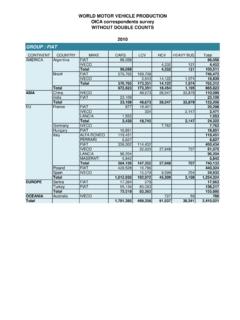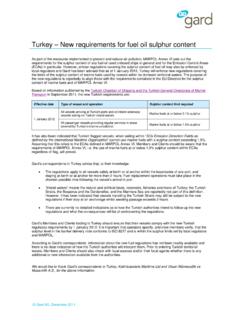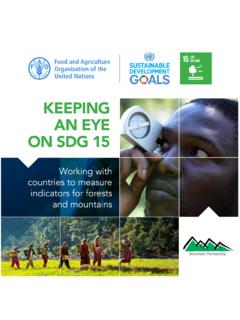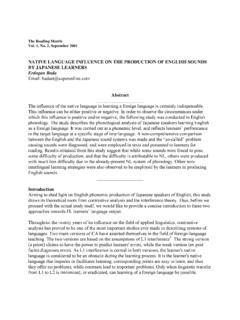Transcription of health workers wages - WHO
1 health workers wages : an overview from selected countries Sigrid Dr ger, Mario R. Dal Poz, David B. Evans Evidence and Information for Policy World health Organization Geneva, March 2006 Background paper prepared for The world health report 2006 - working together for health World health Organization 2006 The designations employed and the presentation of the material in this background paper do not imply the expression of any opinion whatsoever on the part of the World health Organization concerning the legal status of any country, territory, city or area or of its authorities, or concerning the delimitation of its frontiers or boundaries. Dotted lines on maps represent approximate border lines for which there may not yet be full agreement. The mention of specific companies or of certain manufacturers products does not imply that they are endorsed or recommended by the World health Organization in preference to others of a similar nature that are not mentioned.
2 Errors and omissions excepted, the names of proprietary products are distinguished by initial capital letters. All reasonable precautions have been taken by the World health Organization to verify the information contained in this background paper. However, the published material is being distributed without warranty of any kind, either expressed or implied. The responsibility for the interpretation and use of the material lies with the reader. In no event shall the World health Organization be liable for damages arising from its use. This background paper was commissioned by WHO as background for the World health Report 2006. The authors alone are responsible for the views expressed, which do not necessarily represent the decisions or the stated policy of the World health Organization. Rationale Governments intervene in the market for health goods and services in all countries, partly as a result of market failures (1, 2, 3). They have some influence over wages and conditions through public sector employment and through regulating how private sector labour markets operate in general, but their role is often contradictory when it comes to wages .
3 On the one hand, as an employer, they want to keep their costs as low as possible, which means controlling wages . On the other hand, they seek to ensure that there are sufficient health workers to meet population needs, which often cannot be achieved without increasing wages . This balancing act has been made more difficult in recent years by the increasing competition for skilled health workers and the accelerated globalization of health labour markets. The extent of migration of health workers from lower to higher-income countries illustrates that domestic market forces no longer are the sole determinant of wage rates. A good understanding of salaries and wages as push or pull factors for international migration of health workers is therefore essential to countries seeking to develop strategies to retain staff in high-burden disease countries. As the prospect of better remuneration is the single most important cause for migration of health professionals (4, 5), how can adequate remuneration be defined and how much investment is needed first to employ, but also to retain, an adequate number of skilled health workers ?
4 The evidence needed to develop appropriate strategies is lacking, however (5). A major obstacle has been a lack of transparency and comparability of data on wages and occupational classifications, which has prevented assessment of the earnings of health workers across countries, and over time. The variety of sources and diversity of definitions and classifications pose a major challenge to comparative studies (6, 7, 8). To help fill this gap, this paper collates and presents the best available data we have been able to find on salaries across countries. Objective of the paper The overall objective is to describe variations in health worker wages across countries. However, where data are available, we take the opportunity to explore variations within countries between health workers and comparable professionals. We first describe the data available from international databases and discuss the main issues of standardization and comparability. We have not sought to identify national databases, so the results are a first attempt to understand the nature of the variability of wages across settings.
5 Data sources Three main sources for comparable data on health workers ' wages were explored. The first was the October Inquiry and the Occupational wages around the World data file of the International Labour Organization (ILO). The second was the Luxembourg Income and Employment Study (LIS/LES) and the third was data collected by the Organisation for Economic Co-operation and Development (OECD) health Data correspondents. A description of each of these data sources follows. 2 ILO October Inquiry and the Occupational wages around the World (OWW) database ( ) and ( ) The OWW file is derived from the most far-ranging survey of wages by occupation around the world, the ILO's October Inquiry, which is undertaken every year. As countries use different definitions and units when reporting data to the ILO, the database contains data of "acceptable quality" after several adjustments for comparability. These include adjustments for the inclusion of different types of earnings, different types of data by gender ( male, female or average wages ), time spans over which wages are reported and averaging of respondents.
6 Despite this, some problems remain. For example, there are many missing values for various occupations and by country. Furthermore, the monthly average wage reported for the given occupation tends to reflect only basic wages rather than the full earnings received by the worker (9, 10). Nevertheless, the database allows occupational wages to be compared in a relatively standardized way. It contains data for 161 occupations in more than 150 countries from 1983 to 2003. The coding system for occupations follows the International Standard Classification of Occupations (ISCO-88). For the health sector, seven occupations are included: general physician, dentist, professional nurse, auxiliary nurse, physiotherapist, medical x-ray technician and ambulance driver. While this is a good start, it is clear that salary comparisons cannot be made for the several hundred and often country-specific additional categories of health workers (11). The Luxembourg Income and Employment Study ( ) The LIS/LES project compiles household income and labour force studies into a harmonized common database as a source for international comparative studies.
7 For the purposes of our overview, only the labour force surveys are of interest. Even though labour force surveys are regarded as well developed and more compatible than other national surveys, the survey sampling designs and sizes are not homogeneous: while most sampling frames draw on stratified random selections of private households, some datasets are based on income tax or other administrative records of government agencies. The LIS/LES project has developed standardization procedures that transform the microdata of various national labour force surveys into a common variable structure. Those procedures are based on concepts developed by international organizations, such as ILO, UNESCO, OECD and EUROSTAT (12). Currently 30 countries from the Americas, Asia, Europe and Oceania are part of the project; datasets range from 1989 to 2000. The main obstacle for the use of this database for comparative work on health workers ' wages is the diversity in coding the occupations.
8 Some countries apply their own national classification system, which must be mapped to the ISCO coding for comparative analysis. The greater problem, however, is the lack of specificity. Most labour force surveys do not provide further detail than a 2-digit ISCO coding. This means that health professionals appear within the ISCO group 22 "Life science and health professionals". In this case, nurses cannot be differentiated from physicians, pharmacists or even biologists. Of all surveys in the LIS/LES project that are from 1995 or a more recent year, only 10 are detailed enough at a 4-digit ISCO level or equivalent national classification system for a detailed analysis of health occupations. Concerning other variables in the database such as age, sex, gross and net wages and self-employed income, etc., these are all part of the common LIS framework and variable list, but their availability and detail vary from country to country and over time. 3 The OECD health Data National Correspondents Data Collection on Remuneration of Doctors and Nurses Beginning with the OECD health Data 2005 series, some data on remuneration for specific health professions are being compiled as part of the routine OECD health data.
9 Data are collected individually for each country through data correspondents, who identify the most suitable national data sources and methodologies to fit the proposed definitions as far as possible. Sources may vary from administrative data to pay scales of surveys. The goal is to identify the average gross annual income of each occupation, not differentiated by sex. In contrast to the ILO October Inquiry, which records basic wages , the OECD aims to include all extra formal payments such as allowances and overtime payments. So far, data collection has been limited to five types of health workers : salaried nurses in a hospital setting, salaried and self-employed specialists and salaried and self-employed general practitioners. From 1999 to 2005, data on the remuneration of specialists have been gathered for 19 countries, on general practitioners for 15 countries and on hospital nurses for 12 countries (13). The OECD cautions, however, that cross-country comparability of data on remuneration remains quite limited, because different types of payments to employees are included or excluded by different countries, which also use a variety of data sources and calculation methods.
10 Comparison of data sources and data analysis The OECD health Data has the most comprehensive definition on remuneration and therefore provides the most realistic picture of the financial rewards to employees. As the data are specific to only three types of health care categories, however, no comparisons with other occupations are possible. The LIS/LES project allows an overview across occupations and countries and over time, but the availability of data for our specific perspective on the health workforce is rather limited. Several types of analysis were performed with the available data, which showed very similar results to the analysis performed with data from the OWW database, based on a much more comprehensive data pool. Therefore, most of the data for the analysis shown in this overview are drawn from the ILO October Inquiry and the OWW database. The OWW database provides a range of variables for which different calibration procedures have been used to normalize the data.
















